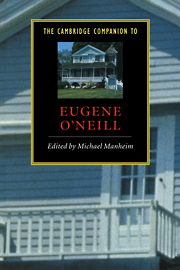Book contents
- Frontmatter
- Introduction
- 1 Celebrant of loss: Eugene O'Neill 1888-1953
- 2 O'Neill's philosophical and literary paragons
- 3 O'Neill and the theatre of his time
- 4 From trial to triumph: the early plays
- 5 The middle plays
- 6 The late plays
- 7 Notable American stage productions
- 8 O'Neill on screen
- 9 O'Neill's America: the strange interlude between the wars
- 10 O'Neill's African and Irish-Americans: stereotypes or “faithful realism”?
- 11 O'Neill's female characters
- 12 "A tale of possessors self-dispossessed"
- 13 Trying to write the family play: autobiography and the dramatic imagination
- 14 The stature of Long Day's Journey Into Night
- 15 O'Neill and the cult of sincerity
- 16 O'Neill criticism
- Select bibliography of full-length works
- Index
6 - The late plays
Published online by Cambridge University Press: 28 May 2006
- Frontmatter
- Introduction
- 1 Celebrant of loss: Eugene O'Neill 1888-1953
- 2 O'Neill's philosophical and literary paragons
- 3 O'Neill and the theatre of his time
- 4 From trial to triumph: the early plays
- 5 The middle plays
- 6 The late plays
- 7 Notable American stage productions
- 8 O'Neill on screen
- 9 O'Neill's America: the strange interlude between the wars
- 10 O'Neill's African and Irish-Americans: stereotypes or “faithful realism”?
- 11 O'Neill's female characters
- 12 "A tale of possessors self-dispossessed"
- 13 Trying to write the family play: autobiography and the dramatic imagination
- 14 The stature of Long Day's Journey Into Night
- 15 O'Neill and the cult of sincerity
- 16 O'Neill criticism
- Select bibliography of full-length works
- Index
Summary
After the fifty-seven performances of Days Without End in 1934, just enough to cover the Theatre Guild subscribers, Broadway would not see another O'Neill play until The Iceman Cometh was produced in 1946. The twelve years between the play that affirmed a sunny faith in God and the play that revealed O'Neill's dark existentialism are referred to as O'Neill's “silence.” Many believed that O'Neill's supposed return to Catholicism, as revealed in Days Without End, marked the end of his artistic powers. Of course, O'Neill did not return to Catholicism, nor did he feel spiritual peace. Quite the contrary, during his absence from Broadway he was engaged in his most intense exploration of his country and himself. Beset by continual physical illness, troubled by his relations with his children and wife Carlotta, deeply disturbed by the miserable state of the world - with Hitler, the world's “iceman,” on the march - O'Neill, exhausted physically and perhaps spiritually, was at the end of his tortuous journey. He was ready to write the plays of his history Cycle, “A Tale of Possessors Self-Dispossessed,” a task not completed, and to write the four last plays which crown his formidable career, plays of the highest accomplishment - The Iceman Cometh (1939), Hughie (1940), Long Day's Journey Into Night (1940), and A Moon for the Misbegotten (1943).
- Type
- Chapter
- Information
- The Cambridge Companion to Eugene O'Neill , pp. 82 - 95Publisher: Cambridge University PressPrint publication year: 1998

